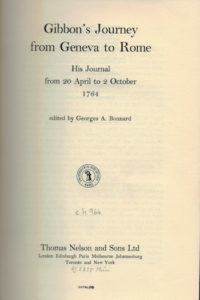
An English historian, renowned for The Decline and Fall of the Roman Empire, also made a Grand Tour in his young adulthood. Between 1763 and 1764, he set off to Italy via France. He visited Rome during this trip, which inspired him to write The Decline and Fall. His account of the Camposanto is brief, but it is long enough for readers to learn about his taste in art. The Camposanto was most likely not his favorite spot in Pisa as the frescoes were not to his liking. He states outright that “They are bad,” and the sarcophagi were “obscene.” According to Gibbon, the most skillful painter appears to be Raphael. Gibbon must have read other literature on the Camposanto as he mentions that the wall paintings are by the “first Restorers of painting.” There is no discussion of the effect of the earth brought from Palestine. /DJ
Source: Edward Gibbon, Gibbon’s Journey from Geneva to Rome. His Journal from 20 April to 2 October 1764, ed. Georges A. Bonnard (London: T. Nelson, 1961), 228-229.
Transcription
“Le Campo Santo est reelment un monument unique et curieux. C’est un grand Cloitre Gothique dont les murs sont peints par les prèmiers Restaurateurs de la peinture, un Giotto &c. Elles sont mauvaises, mais il faut se transporter aux tems où elles etoient rares et precieuses. Le gout et la grandeur d’un Etat ne consiste qu’à encourager les meilleurs artistes de leur tems. Ils ne sauroient toujours former des Raphaels. L’interieur du Cloitre est le Cimetiere du peuple Pisan, rempli de la terre sainte que leurs Vaisseux ont apportè de la Palestine. Parmi ces vestiges de Devotion on appercoit les Sarcophages payens et souvent obscenes dont le Cloitre est repli. Comme il y en a très peu qui porte[nt] des inscriptions, on ignore s’ils sont Pisans ou Etrangèrs. Je les crois des bas Siecles de Paganisme. J’en juge ainsi sur le travail qui est fort mauvais, sur les Visages qui sont la plupart en plein, et sur la forme des lettres qui diviennent minces, pointures et Gothiques. Ces sarcophages sont extremement gatés […]”
Translation
The Campo Santo is truly a unique and curious monument. It is a large gothic cloister of which the walls are painted by the first Restorers of painting, by Giotto and others. They are bad, but one must transfer oneself to the times when they were rare and precious. The taste and greatness of a state is only to encourage the best artists of their time. They couldn’t always train Raphaels. Inside the cloister is the graveyard of the Pisan people, filled with the holy land that their vessels brought from Palestine. Among these vestiges of devotion, we can see the pagan and often obscene sarcophagi with which the cloister is filled. As very few of them bear inscriptions, it is not known whether they are Pisan or foreign. I believe they are from the low centuries of paganism. I make this judgement based on the work, which is very bad, on the faces, which are mostly full, and on the shape of the letters, which are thin, pointed and Gothic. These sarcophagi are extremely spoiled […]
